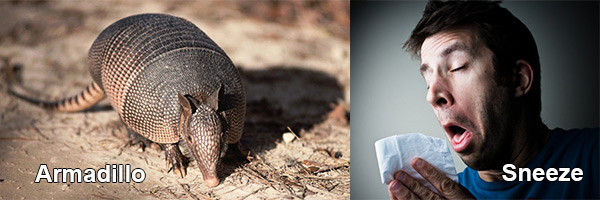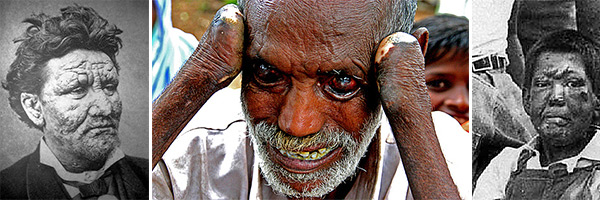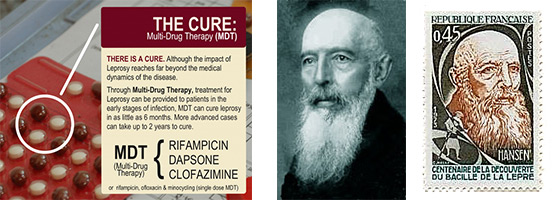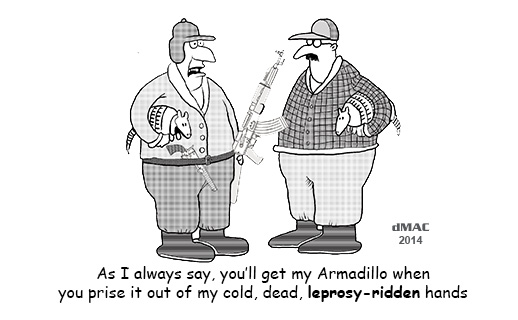Duncan MacDonald
Jakarta 20 January 2014
Reviewed 18 February 2022

What is Leprosy?
Leprosy is a chronic bacterial disease of the skin and nerves in the hands and feet. In some cases it effects the lining of the nose. Although the mode of transmission of leprosy remains uncertain, it is believed leprosy is usually spread from person to person in nasal droplets when an infected person coughs or sneezes. If you breath these in, you may become sick with the disease. However the bacteria that causes leprosy grows very slowly. It may take 2-10 years before any symptom show.The WHO (World Health Organisation) states around 95% of people are naturally immune to leprosy or Hansen’s disease.
Studies have shown leprosy can also be transmitted to humans by armadillos, the primary source of infection in North and South America. About one third of the 150 - 250 leprosy cases occurring annually in the United States, result from contact with infected armadillos. The cases are concentrated in Louisiana and Texas, where some people hunt, skin and eat armadillos. [1]
Leprosy now joins a host of other infectious diseases - including Flu (influenza), HIV/AIDS, and SARS - that are known to have jumped from animals to humans. Flu is thought to have crossed to humans from migratory waterfowl several hundred years ago. HIV/AIDS first crossed from a chimpanzee 90 years ago.

The interesting aspect of leprosy is that transmission seems to have gone in both directions. Leprosy was not present in the New World (North & South America) before Christopher Columbus (1492 AD), and armadillos are indigenous to the New World. So armadillos had to have acquired it from humans sometime in the last 500 years. [2]
 The bacteria that cause leprosy grow very slowly. It may take 2 - 10 years before signs and symptoms appear. It mainly affect the skin, nerves and mucous membranes (the soft, moist areas just inside the body’s openings).
The bacteria that cause leprosy grow very slowly. It may take 2 - 10 years before signs and symptoms appear. It mainly affect the skin, nerves and mucous membranes (the soft, moist areas just inside the body’s openings). The disease can cause:
● Skin lesions that may be faded/discolored
● Growths on the skin, nodules on both sides of the body
● Thick, stiff or dry skin
● Severe pain
● Numbness on affected areas of the skin
● Muscle weakness or paralysis (especially in the hands and feet)
● Eye problems that may lead to blindness
● Enlarged nerves (especially those around the elbow and knee)
● A stuffy nose
● Nosebleeds
● Ulcers on the soles of feet
Since leprosy/Hanson’s disease affects the nerves, loss of feeling or sensation can occur. When loss of sensation occurs, injuries (such as burns or fractures) may go unnoticed. Always try to avoid injuries. But if you experience loss of sensation due to leprosy (or another cause), you may not feel pain that can warn you of harm to your body. So take extra care to ensure your body is not injured.
Contrary to folklore, leprosy does not cause body parts to fall off. Secondary infections however can result in tissue loss resulting in fingers and toes to become shortened and deformed. The nose cartilage can be absorbed by the body, as a consequence the nose will disappear.
Leprosy is easily treated with a combination of antibiotics for 6 months to 2 years. MDT (Multi-Drug Thedrapy) remains highly effective and people are no longer infectious after the first monthly dose.The drugs used in MDT are a combination of rifampicin, clofazimine and dapsone for MB leprosy patients and rifampicin and dapsone for PB leprosy patients. Among these rifampicin is the most important antileprosy drug and therefore is included in the treatment of both types of leprosy. Treatment of leprosy with only one antileprosy drug will always result in development of drug resistance to that drug. Treatment with dapsone or any other antileprosy drug used as monotherapy should be considered as unethical practice. [3]
Between 1995 and 1999 WHO, with the aid of Nippon Foundation, supplied all endemic countries with free MDT in blister packs, channelled through Ministries of Health. This free provision was extended in 2000 and again in 2005 with donations by the MDT manufacturer Novartis. In the latest agreement between the company and WHO, the provision for free MDT to all countries will run until the end of 2015.

MDT Multi-Drug-Therapy Dr Gerhard Henrik Armauer Hansen (1841 – 1912)
The earliest possible account of a disease that many scholars believe is leprosy appears in an Egyptian Papyrus document written around 1550 BC. Around 600 BC Indian writings describe a disease that resembles leprosy. In Europe, leprosy first appeared in the records of ancient Greece after the army of Alexander the Great came back from India 322 BC, and then in Rome in 62 BC coinciding with the return of Pompeii's troops from Asia Minor. [4]The word “leprosy” is derived from either the Indo-European word lap, which means ‘the removal of scales’ or the Greek word for ‘scales’, lepra.
Historically infected people were often confined against their will in leper colonies. In Medieval Europe lepers were required to carry a bell to identify their presence. India currently has over 700 leper colonies.
The causative agent of leprosy, Mycobacterium leprae was discovered by Norwegian Dr G.H. Armauer Hansen in 1873 (hence Hansen’s disease). This was the first bacterium to be identified as causing disease in humans. World-wide as many as 2 million people are permanently disabled as a result of leprosy. You may be at risk for the disease if you:
► live in a country where the disease is endemic. Such countries include: ◊ Angola, ◊ Brazil, ◊ Central African Republic, ◊ Democratic Republic of Congo, ◊ Federated States of Micronesia, ◊ India, ◊ Kiribati, ◊ Madagascar, ◊ Mozambique, ◊ Nepal, ◊ Republic of Marshall Islands, ◊ United Republic of Tanzania.
Endemic is defined as reaching a prevalence of 1 or more leprosy cases per 10,000 population.
► are in prolonged close contact with people who have untreated leprosy. If they have not been treated, you could be exposed to the bacteria that causes leprosy. As soon as the patients start treatment, however, they are no longer able to spread the disease. According to WHO report in September 2012, leprosy remains endemic in some areas of Brazil, Congo, India, Indonesia, Madagascar, Mozambique, Nepal, Philippines and Tanzania. Registered prevalence of leprosy globally in 2012 was 181,941 cases, 2011 had 219,075 and 2010 recorded 228,474. The good news is the trend is downward.
India continues to record the highest number of new leprosy cases in the world 83,041* (126,600 in 2010), followed by Brazil 29,761* (34,894 in 2010) and Indonesia 19,785* - of which 1,904 or 11.2% were under age 15. (*2011 figures).
Latest figures for Indonesia from the Ministry of Health (20 Feb 2013) reported 20,023 new cases of leprosy. This represents only 0.83 per 10,000 head of population. Note: Southern India has 5.58 per 10,000.
Indonesia’s Minister of Health Nafsiah Mmboi, said 'the community should stop the discrimination and stigma against suffers of leprosy, because once treatment is started it is non-contagious and does not affect a person’s ability to work'.
Editors Note: While Indonesia’s 20,023 new cases of leprosy is of concern,it pales against the 185,000 Indonesian who died of TB in 2012 - and TB is curable.

This Digest article can be downloaded as a FREE e-book on Smashwords.
Available on iPad / iBooks, Kindle, Nook, Sony, & most e-reading apps including Stanza & Aldiko.
Just click the following link
>> download free e-book dMAC Digest Vol 4 No 2





